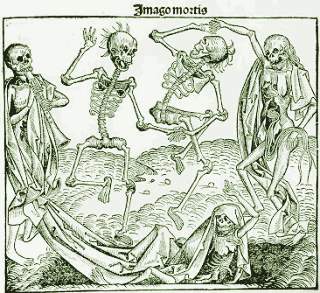Special Dossier: DEATH - THE DANCE OF DEATH

Danse Macabre by Holbein
In the Great Plague of 1348-50, a third of Europe's population is thought to have perished in the Black Death
The terrible suffering and mass graves gave rise to what the French called la Danse Macabre. Ecclesiastical Annals from Germany describe the dance as a kind of mania, characterized by Bacchantic leaps. At Aix-la-Chapelle in 1374, the dancers held hands to form circles and whirl around until they dropped. At even greater heights of frenzy, the first fell to the ground in epileptic convulsions, gasping for air and foaming at the mouth, until they could leap up to perform the strange contortions of the dance.
In the French tradition, the dance's legacy is found in 14th century poetry, frescoes and woodcuts depicting representatives from every station of life, from pope to pauper, paired with ghostly doubles who have come to summon the living partner to the other world. Death, often personified with a sickle in hand for the harvest, came to represent the great leveller of all inequality.
The tradition did not end with the Middle Ages. Periodic outbursts of the plague in the 16th century sparked similar reactions, as shown in Hans Holbein's series of woodcuts on the Totentanz, executed in Basle (c.1523-26). Today, la danza de la muerte is still performed in Spain at festivals by single drummers with skeletal partners who circulate together around inside cavernous cathedrals.


<< Home